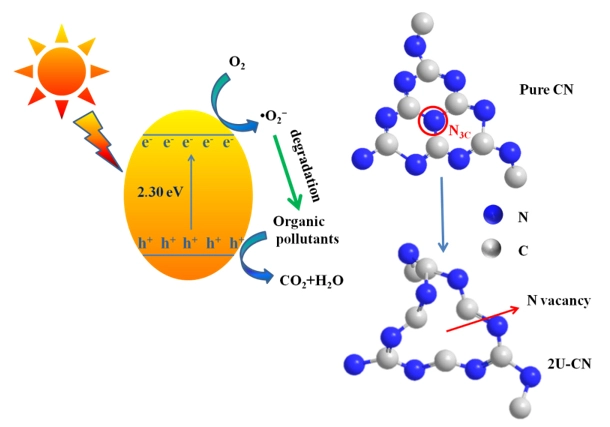Mar 18 2020
A new study highlights the significance of defect engineering to boost catalytic performance through a simple, efficient technique to modify and optimize graphitic carbon nitride (g-C3N4), a metal-free semiconductor photocatalyst, to overcome the dual challenges of shortage of fossil resources and environmental pollution.
 A schematic illustration of modified g-C3N4 by nitrogen vacancies and reaction mechanisms. The nitrogen vacancies not only increased the specific surface area, exposing more active sites, but also inhibited the recombination of photogenerated carriers on the surface of photocatalysts, resulting in the enhancement of photocatalytic and electrocatalytic performances. Image Credit: Kai Yang.
A schematic illustration of modified g-C3N4 by nitrogen vacancies and reaction mechanisms. The nitrogen vacancies not only increased the specific surface area, exposing more active sites, but also inhibited the recombination of photogenerated carriers on the surface of photocatalysts, resulting in the enhancement of photocatalytic and electrocatalytic performances. Image Credit: Kai Yang.
The study was performed by researchers from the Jiangxi University of Science and Technology, Guangdong University of Petrochemical technology, Gannan Medical University, and Nanchang Hangkong University in China. It was reported in the NANO journal.
In the 21st century, with the fast growth of population and industrialization, the two major difficulties facing sustainable social development are the shortage of fossil resources and environmental pollution. Therefore, it is very crucial to develop green treatment technology.
Thanks to its non-toxic, green, and highly efficient nature by making use of solar energy, semiconductor photocatalysis technology has turned out to be one of the most potent techniques.
Graphitic carbon nitride (g-C3N4) has recently gained considerable attention as a new semiconductor photocatalyst of non-metallic polymer in the photo-catalytic field due to its optical properties and improved stability. Since bare g-C3N4 has a smaller surface area and experiences fast recombination of photogenerated carriers when irradiated by visible light, its photocatalytic activity is insufficient.
In this study, the researchers used urea as the activated support for the nitrogen vacancies based on the bare g-C3N4 through melamine calcination. This resulted in a considerable enhancement of photocatalytic performance for the degradation of organic dyes in water, like acid orange II, rhodamine (RhB), methyl blue (MB), and methyl orange (MO) under visible light irradiation (λ > 420 nm).
Electrocatalytic performance for hydrogen evolution was thus realized as a result of wider light response, as well as efficient production and migration of electron or hole charge carriers.
The researchers believe that this study will offer a concept for the novel design, production, and fabrication of modified g-C3N4 and alternative N-based photocatalysts. This catalyst could potentially be used to treat environmental pollutants and to generate new energy.
This study was funded by the National Natural Science Foundation of China (Nos. 21962006, 21707055, 21607064, and 21567008), Youth Key Project of Jiangxi Province Nature Science Foundation (20192ACBL21011), and Program of Qingjiang Excellent Young Talents of Jiangxi University of Science and Technology (No. 3401223429).
Further support was offered by Program of 5511 Talents in Scientific and Technological Innovation of Jiangxi Province (No. 20165BCB18014), Academic and Technical Leaders of the Main Disciplines in Jiangxi Province (No. 20172BCB22018), Jiangxi Province Natural Science Foundation (Nos. 20181BAB213010 and 20181BAB203018), Project Supported by Guangdong Province Universities and Colleges Pearl River Scholar Funded Scheme (2019).
The study was also supported by Young Science Foundation of Jiangxi Province Education Office (No. GJJ160671), Open Project Program of the State Key Laboratory of Photocatalysis on Energy and Environment in Fuzhou University (No. SKLPEE-KF201712) and Open Fund of Guangdong Provincial Key Laboratory of Petrochemical Pollution Process and Control, the Guangdong University of Petrochemical Technology (No. 2018B030322017).